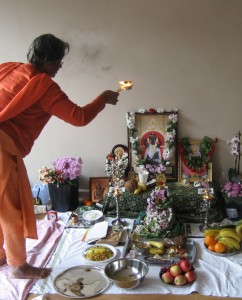Q: If God is not a separate entity and just a symbol for different qualities then how does one proceed with Bhakti?
Bhakti develops unconditional love for God. But shouldn’t this love be for our loved ones rather than for a God whom I have never seen? Isn’t that closer to reality?
I was doing Naam japa and getting immense benefits out of it but these questions have confused me, and I have stopped practicing this. People who are Self-realized also do Bhakti, don’t they? To whom do they pray?
A: There are two main points here.
First, since you are asking a question about Advaita, you must appreciate that, in reality there is only Brahman, or Consciousness. From the empirical standpoint, of course, you see a dualistic world with other people etc. and, from this point of view, it is not unreasonable to speak of a god, or gods. But anything to do with this empirical point of view has to be provisional only. It all has to be acknowledged as simply name and form of that non-dual reality eventually. That ‘acknowledgement’, and the firm belief that it is true, is what we call ‘enlightenment’.
Continue reading




